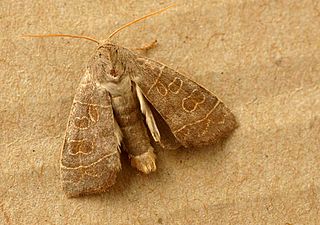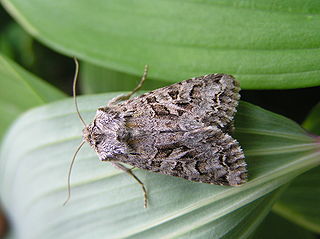
The garden dart is a moth of the family Noctuidae. It is distributed throughout much of the Palearctic. Temperate regions of Europe, Central Asia and North Asia, as well as the mountains of North Africa. Absent from polar regions, on Iceland and some Mediterranean islands, as well as in Macaronesia.

Orthosia incerta, the clouded drab, is a species of moth of the family Noctuidae, found in Europe and Asia. The occurrence of the species extends through all European countries through the Palearctic to the Russian Far East and Japan. It is absent from northern Fennoscandia and in the Alps it occurs up to 2000 m above sea level.

Atethmia centrago, the centre-barred sallow, is a moth of the family Noctuidae. The species was first described by Adrian Hardy Haworth in 1809. It is found in Europe except Scandinavia and Italy; also in Asia Minor, Armenia, Syria and Palestine.

Ipimorpha subtusa, the olive, is a moth of the family Noctuidae. It is found in the Palearctic realm.

Hada plebeja, the shears, is a moth of the family Noctuidae. It is found in Europe and across the Palearctic to Asia Minor, Armenia, Turkestan, Central Asia, Mongolia, Siberia, as well as Kashmir.

Pyrrhia umbra, the bordered sallow, is a moth of the family Noctuidae. The species was first described by Johann Siegfried Hufnagel in 1766. It is found in all of Europe, east through Anatolia to Iran, Afghanistan, Pakistan and Nepal and through central Asia to Japan. In mountains it can be found up to elevations of 1,600 meters.

Tiliacea citrago, the orange sallow, is a species of moth of the family Noctuidae. It is found in Europe as far east as the Caucasus Mountains and the Urals.

Xanthia togata, the pink-barred sallow, is a species of moth of the family Noctuidae. It is a Holarctic species, and is found throughout Europe and east through the Palearctic to Central Asia, and Siberia up to the Ussuri. The distribution area includes the United States and Canada. It was first described by the German entomologist Eugenius Johann Christoph Esper in 1788 from the type specimen in Germany

The Early Grey(Xylocampa areola) is a species of moth of the family Noctuidae. It is found in Europe and Morocco.

Enargia paleacea, the angle-striped sallow, is a moth of the family Noctuidae. It is found in the Palearctic realm from Ireland to Siberia East to Japan.

The barred Sallow(Tiliacea aurago) is a moth of the family Noctuidae. It is found in Europe.

Xanthia gilvago, the dusky-lemon sallow, is a moth of the family Noctuidae. The species was first described by Michael Denis and Ignaz Schiffermüller in 1775. It is found in Europe.

The pale-lemon sallow is a moth of the family Noctuidae. It is found from Europe to Anatolia and Morocco.

Conistra rubiginea, the dotted chestnut, is a moth of the family Noctuidae. The species was first described by Michael Denis and Ignaz Schiffermüller in 1775. It is distributed in Europe and, according to William Warren, Armenia and Asia Minor.

Catocala electa, the rosy underwing, is a moth of the family Erebidae. The species was first described by Karl Friedrich Vieweg in 1790. It can be found in Europe and Asia.

Nycteola revayana, the oak nycteoline, is a moth of the family Nolidae. The species was first described by Giovanni Antonio Scopoli in 1772. It is found from Europe and east across the Palearctic to Japan and India.

Aporophyla australis, the feathered brindle, is a moth in the family Noctuidae. The species was first described by Jean Baptiste Boisduval in 1829. It is found in western and southern Europe, North Africa and the Middle East.

Elaphria venustula is a moth of the family Noctuidae. It is found in most of Europe, except the north. In the east, the range extends through the Palearctic to the Pacific Ocean.

The Beautiful Gothic(Leucochlaena oditis) is a Palearctic moth of the family Noctuidae, sub-family Cuculliinae. It is found in southern Europe and north Africa, with occasional finds on the southern coast of England.

Eriopygodes imbecilla, the Silurian, is a moth of the family Noctuidae first described by Johan Christian Fabricius in 1794.





















